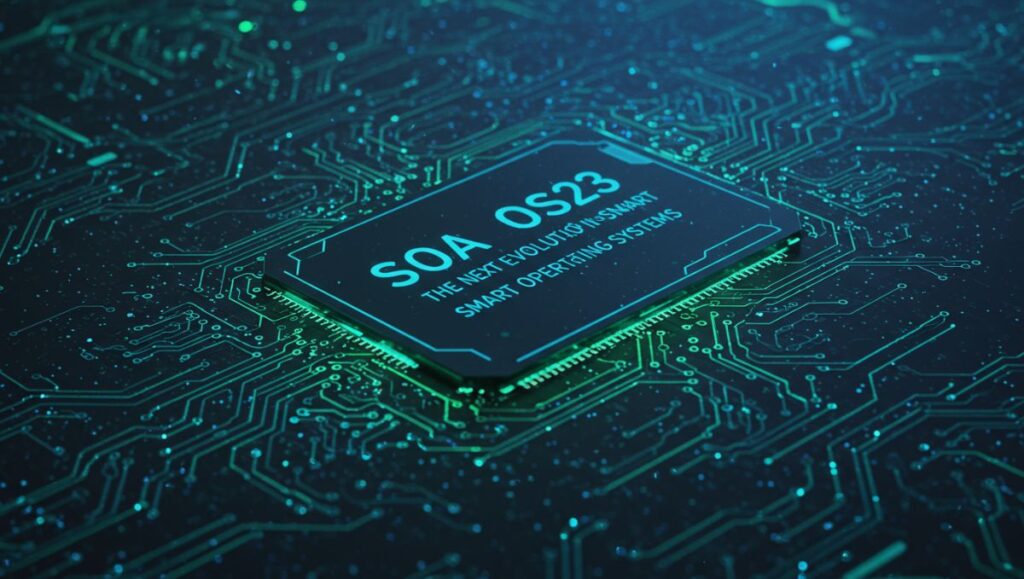In the rapidly evolving world of technology, operating systems define how humans interact with machines. From the early days of simple command-line interfaces to today’s sophisticated, AI-driven ecosystems, the software world has continuously adapted to meet growing demands.
Enter SOA OS23 — a next-generation operating system designed to revolutionize how users experience performance, security, and connectivity. Built on a foundation of Service-Oriented Architecture (SOA) principles, SOA OS23 is not just another software update — it’s a complete reimagining of system efficiency, integration, and adaptability.
With scalability, modular design, and cloud connectivity at its core, SOA OS23 represents a major leap forward in how operating systems support the future of computing.
What Is SOA OS23?
SOA OS23 stands for Service-Oriented Architecture Operating System, Version 23. It is a next-generation software platform that integrates modular services, microarchitecture, and intelligent automation to deliver seamless performance across devices.
Unlike traditional monolithic operating systems, SOA OS23 is built around independent, service-based components — allowing developers and enterprises to customize, deploy, and scale functionalities based on their unique requirements.
In simple terms, SOA OS23 is a flexible and intelligent operating system designed to adapt to modern computing environments — from desktop and mobile to IoT and cloud-based ecosystems.
The Philosophy Behind SOA OS23
At the heart of SOA OS23 lies a powerful concept: decentralized efficiency through modular architecture.
Traditional operating systems often rely on a single, rigid structure, making updates complex and integration challenging. SOA OS23, however, takes inspiration from Service-Oriented Architecture, where each component — known as a service — performs a specific function independently while communicating with other services through a unified framework.
This means that every part of the system can be updated, replaced, or scaled without affecting the rest of the OS.
Core Principles of SOA OS23:
-
Modularity: Every feature operates as an independent service.
-
Scalability: Easy integration with additional tools or platforms.
-
Interoperability: Seamless connection between devices and systems.
-
Resilience: Fault-tolerant design for continuous uptime.
-
Agility: Faster deployment and updates with minimal disruption.
SOA OS23 embodies the essence of modern software philosophy — flexibility without compromise.
The Architecture of SOA OS23
The architecture of SOA OS23 sets it apart from conventional operating systems. It’s designed with a microservice-oriented core that enables dynamic resource allocation, real-time processing, and self-optimization.
Key Architectural Layers:
1. Kernel Layer
The heart of SOA OS23, responsible for managing resources, memory, and device interactions. Unlike traditional kernels, it uses smart orchestration logic to balance performance across services dynamically.
2. Service Layer
The modular backbone that allows developers to plug in new components or remove unused ones. This makes customization effortless — ideal for both enterprise and consumer users.
3. Integration Layer
A communication bridge that enables data flow between applications, APIs, and external platforms such as cloud services or IoT devices.
4. Security and Governance Layer
Built with encryption, zero-trust protocols, and compliance automation, this layer ensures that SOA OS23 remains one of the most secure operating systems ever built.
5. User Experience Layer (UXL)
A highly responsive, adaptive interface that personalizes layout, features, and visual themes using AI-driven user behavior analysis.
This multi-layered design makes SOA OS23 highly adaptable across diverse environments — from personal devices to enterprise-scale cloud infrastructures.
Intelligent Automation and AI Integration
One of the biggest advancements in SOA OS23 is its integration with artificial intelligence and automation frameworks.
Through its AI orchestration engine, the OS can:
-
Predict system performance bottlenecks before they occur.
-
Optimize memory and CPU usage in real time.
-
Automate software updates and patch management.
-
Provide intelligent suggestions for system configuration.
-
Enable adaptive UI changes based on user habits.
The AI core in SOA OS23 doesn’t just react — it learns, ensuring that the system becomes more efficient, secure, and personalized with each use.
Security: The Zero-Trust Foundation
In an age of cyber threats, SOA OS23 introduces a zero-trust security model that protects users at every level. Instead of assuming internal network safety, the system continuously verifies every user, device, and application.
Security Features Include:
-
End-to-end encryption for all communications.
-
AI-powered intrusion detection and threat response.
-
Sandboxed environments for app isolation.
-
Decentralized authentication systems powered by blockchain verification.
-
Quantum-ready encryption protocols for future-proof data protection.
With cybersecurity embedded into its architecture, SOA OS23 ensures uncompromised protection without sacrificing performance.
Cloud and Edge Compatibility
SOA OS23 is built for the cloud-first generation. Whether deployed on-premises, in hybrid data centers, or on public cloud platforms, it offers unmatched scalability and speed.
Additionally, its edge computing compatibility ensures real-time data processing closer to the source — minimizing latency and improving efficiency for IoT and industrial automation applications.
By integrating seamlessly with platforms such as AWS, Azure, and Google Cloud, SOA OS23 enables organizations to run secure, distributed systems while maintaining central visibility and control.
Performance and Efficiency
Thanks to its service-based architecture, SOA delivers significant performance improvements over legacy operating systems.
Performance Highlights:
-
30% faster boot times through asynchronous startup services.
-
Dynamic resource allocation, ensuring optimal CPU and memory usage.
-
Automatic process balancing to prevent system overload.
-
Real-time analytics for continuous performance monitoring.
The system intelligently prioritizes tasks based on context — whether for gaming, cloud rendering, or business workloads — ensuring peak performance under any condition.
Developer Ecosystem and API Integration
SOA OS23 comes with a robust developer ecosystem that supports multiple programming languages, SDKs, and APIs.
The built-in SOA Developer Studio allows developers to build, deploy, and test modular services quickly. With API-first design, integration into existing systems is straightforward, enabling innovation across industries.
Supported languages include Python, Java, Rust, and C++, while the Open SOA Framework (OSF) ensures compatibility with existing enterprise applications.
This developer-first focus positions SOA as an ideal platform for innovation in sectors like healthcare, finance, manufacturing, and AI-driven automation.
User Experience and Interface Design
SOA OS23 redefines how users interact with their devices. Its adaptive interface personalizes the experience based on user habits, device type, and performance context.
UX Innovations Include:
-
Customizable dashboards with live service widgets.
-
Gesture and voice control for hands-free navigation.
-
AI-assisted accessibility features for differently abled users.
-
Cross-device synchronization, allowing seamless switching between desktop, tablet, and mobile environments.
The result is a smooth, intuitive experience that feels both futuristic and familiar — striking the perfect balance between functionality and design.
Industry Applications
The flexibility of SOA allows it to be deployed across a wide range of industries and use cases:
1. Enterprise IT
Scalable microservices architecture for cloud-native business operations.
2. Healthcare
Secure data sharing and real-time patient monitoring powered by SOA OS23’s encrypted frameworks.
3. Manufacturing and IoT
Edge computing and predictive analytics for smart factories.
4. Finance
Enhanced compliance, auditing, and transaction security via blockchain-integrated modules.
5. Education and Research
Collaborative cloud environments supporting digital learning and AI modeling.
SOA OS23’s adaptability ensures that any organization — regardless of size or industry — can leverage its power.
Compatibility and Integration
SOA supports both legacy and modern systems, offering hybrid compatibility across:
-
Windows, macOS, and Linux environments.
-
Android and iOS mobile ecosystems.
-
IoT and embedded systems hardware.
The system’s interoperability layer allows seamless migration from older platforms, ensuring that businesses can modernize without disruption.
Its backward compatibility also means users can run existing applications without modification while still benefiting from enhanced performance and security.
The Future of SOA OS23
As technology continues to advance, SOA OS23 is positioned at the forefront of the next wave of intelligent, connected systems.
Future versions will likely introduce:
-
Full AI governance frameworks for autonomous system management.
-
Quantum-ready computation modules.
-
5G and 6G optimization layers for faster network performance.
-
Expanded developer ecosystems for open-source collaboration.
SOA OS23 isn’t just keeping up with the digital future — it’s actively shaping it.
Why SOA OS23 Matters
The release of SOA represents more than a software milestone — it signals the dawn of adaptive, service-driven operating systems designed for flexibility, intelligence, and longevity.
Its fusion of modular architecture, AI integration, and zero-trust security provides a foundation for everything from smart devices to enterprise-scale cloud systems.
For developers, businesses, and users alike, SOA offers what few operating systems can — control, scalability, and creativity in perfect harmony.
Conclusion
In a world where technology evolves at lightning speed, SOA OS23 stands as a symbol of progress — a system that learns, adapts, and grows alongside its users.
With its focus on modularity, automation, and security, it offers not just better performance but a fundamentally smarter way of computing.
As organizations and individuals embrace digital transformation, SOA OS23 will serve as the backbone of a more connected, efficient, and intelligent future — where software truly works for the user, not the other way around.






